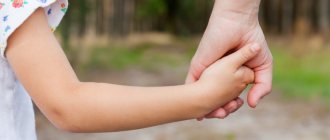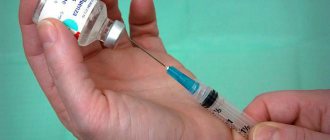It's terrible when a dog bites a child. For many, an attack is a reason to get rid of an animal that poses a potential danger to household members. But what will happen if we say that in any attack by a dog on a child, it is not the dog or even the child who is to blame - the parents are to blame for allowing the tragedy to happen?
American scientists from Duke University found that dogs bite children much more often than adults, and up to 75% of bites are committed by pets. And this attack can almost always be prevented.
We tell you why dogs bite children and what to do to prevent this from happening.
Why did the dog attack the child?
The first question that arises for any parent. The family bumpkin, the favorite of the whole family, suddenly turned into a teeth-clanging monster, aiming at the child’s face! How could this happen?
The average victim of dog bites is a child under 10 years of age, usually a boy, who has been left alone with a dog for some time. Not trained to properly handle an animal, he reached into the bowl or tried to take away his favorite toy. That's it - the ending is a little predictable.
Typically, the results of a domestic dog attack are not too bad: a scratch from the fangs on the cheek or a bruise on the forearm. The dog attacks quickly, but without the goal of causing significant harm. Her job is to intimidate.
But this does not make the bite any less unpleasant. The psyche also suffers, because a frightened child can develop a phobia.
Skin and soft tissue infection
Having talked about the most dangerous, we will talk about the most common consequence.
Dogs have a huge amount of bacteria on their teeth, which, when bitten, enter the skin and soft tissues, where they multiply and cause inflammatory diseases. In a short time, phlegmon can develop at the site of even a small abrasion or scratch. First aid always begins with the prevention of this complication.
This does not require any specific vaccines. It is necessary to clean the wound, rinse it well and treat it with antiseptics. In the emergency room, if necessary, primary surgical treatment is performed and local anti-inflammatory therapy is prescribed. For extensive bite wounds, systemic antibacterial and anti-inflammatory therapy is prescribed.
How to protect your child from someone else's dog
What to do if a child is attacked by a strange dog? This happens very rarely. Sometimes the culprit is an irresponsible owner who lets an aggressive animal roam without a leash, but this happens so rarely that the incident can be attributed to a statistical error. And you can’t do anything about them - unfortunately, it’s impossible to protect yourself from other people’s idiocy.
But most often the dog is provoked to attack by a child. The child is not to blame - he was not taught how to properly treat animals. His parents are solely to blame for this situation.
What to do to prevent a child from being bitten by a strange dog? Follow the basic rules!
- Ask the dog owner for permission before allowing a child near the animal. You don’t know how calm and sociable the dog is, whether she likes children, or whether she wants to be stroked. Some animals can be anxious, fearful or aggressive, some simply do not like small children.
- Lead the child to the dog by the hand. Having received permission, the child can rush headlong towards the dog and scare it. Instill in children the culture of communicating with animals from an early age - take them by the hand, show them how to stroke them, explain that they should not pull the animal’s fur or pinch it.
- Stop contact as soon as the dog shows signs of discomfort and if the owner asks you to stop.
- Ask the owner's permission if you want to give the dog something to eat. Remember that the treat should be held out in an open palm, and not held between your fingers. And don’t give animals sugar and chocolate - it’s harmful.
- Do not approach tied dogs. Dogs are usually attached for a reason. Plus, animals whose freedom of movement is limited often feel vulnerable. They are scared and unpleasant; there is no need to increase their anxiety.
- Don’t scare your child with “scary” dogs! The surest way to give a child cynophobia (fear of dogs) is to endlessly frighten him with all the animals he meets, even if a fluffy and affectionate Samoyed is walking towards him. There is no need to say: “Behave decently, otherwise I will feed you to that dog.” And this is also unpleasant for the owners - they can have the most affectionate and well-mannered dog, but they call him some kind of Baskerville dog.
Showing it to a doctor: when is it necessary and when is it desirable?
A visit to the doctor is required in the following cases:
- the dog was a street dog, rabid, unvaccinated, not vaccinated on time;
- bite wounds are deep, extensive, serious (may need to be stitched up).
If the bite was such that it did not require a visit to the emergency room or hospital, then you should see a doctor when:
- after the bite, the child’s temperature rises, the wound is inflamed and festers;
- tachycardia develops, the baby gets cold, sweating increases;
- the lymph nodes near the bite site are inflamed.
In this case, there is a suspicion of sepsis, which requires quick measures. Therefore, you should promptly get an appointment with a doctor.
How to protect your child from your dog
If you decide to have a dog in a family with a child, you will have to set rules. Follow them yourself and make sure your child follows them.
1. Teach your dog basic commands. You can do this yourself using books and tutorials from the Internet, you can take your animal to OKD courses, or you can entrust everything to a professional dog handler. You must have a manageable city dog - an animal absolutely obedient to its owner. Only such a dog is safe for people.
2. From puppyhood, teach your dog not to show food aggression. Dogs guard food, bedding, toys - they protect a resource. This should not happen in a family where the animal is at a lower hierarchical position. If you start to notice that the dog is growling, as soon as you appear at the bowl, contact a dog handler. There are humane methods that will wean a dog from guarding resources.
3. Forbid the child to disturb the dog while eating and sleeping, even if the dog is not guarding the resource.
4. Teach children to respect animals and their personal space. Yes, a dog may be interested in playing, but sometimes he wants to be alone. Just like a person.
5. Do not leave small children and dogs unattended. The kindest dog in the world can become enraged if you poke a pencil in its eye.
6. Teach your child to see when the dog is unhappy and to respond correctly to this dissatisfaction.
7. Give the dog a shelter - a kennel, a cage, a bed. Prohibit your child from chasing the animal there. That’s it, the dog is “in the house”, no need to get it out.
And remember: for any troubles that happen between a dog and a child, only you are to blame.
Rabies and tetanus
Gram-positive rod - the causative agent of tetanus
In terms of mortality, tetanus is second only to rabies. The fatality rate is 50-80%, with the latter figure being more accurate. The most severe course of the disease is in newborns: death occurs in 100% of cases.
The causative agent of tetanus is a gram-positive rod. This dangerous microbe lives in the intestines of animals and humans without causing harm to them. But when it enters an anaerobic environment, which is typical for a deep wound, the stick begins to produce a strong poison - tetanus toxin. It affects the nervous system, causing opisthotonus - convulsive arching of the body with support on the back of the head and heels.
Humans are infected with rabies when dog saliva infected with the Rabies virus gets into a wound. The pathogenic microorganism penetrates the human cerebral cortex through nerve pathways, causing disturbances in the functioning of all organs.
If a rabid dog damages a child's soft tissues, rabies infection is inevitable. Even if the dog has just injected itself with a fang, left abrasions or small scratches, this is already a cause for alarm.
Symptoms
From the moment the Rabies virus enters the body until the onset of symptoms, it takes from 10 days to 4 months. The medical literature has described cases where the disease did not manifest itself for a year. The duration of the incubation period depends on the location of the bite: the further from the head, the later the symptoms appear.
Signs of rabies infection depend on the stage of the disease:
- The prodromal period (early) is characterized by low-grade fever, anxiety, poor sleep, pain at the site of the bite. Lasts 1-3 days.
- Stage of heat, or aggression. Its duration is no more than 4 days. The patient reacts sharply to bright light and sounds of any intensity. Salivation increases, fear, hallucinations, and aggression appear. At the sight of water, a spasm of the pharynx occurs, and the movement of air causes muscle spasms in the limbs.
- Stage of paralysis. The convulsions stop, indicating the approach of death. The muscles of the eyes and face are paralyzed (the jaw drops), the temperature rises to +42°C, and blood pressure drops. Death occurs from suffocation or cardiac arrest.
The disease lasts no more than 8-10 days.
Tetanus is manifested by the following symptoms:
- difficulty swallowing;
- convulsive spasms of the masticatory muscles (trismus), which cause the mouth to open;
- tension in the abdominal muscles and limbs;
- urinary disturbance;
- temperature increase;
- cyanosis;
- apnea;
- insomnia.
The key symptom of tetanus is tetanic spasms of the facial muscles, which cause a sardonic smile. This is a dangerous symptom, after the appearance of which treatment becomes meaningless: the spread of seizures to other parts of the body occurs in a matter of hours. Death occurs from respiratory arrest or paralysis of the heart muscle.
Prevention
Prevention of rabies and tetanus is primary and secondary. Primary measures include measures aimed at eliminating the risk of developing the disease.
To avoid getting rabies, you need to properly treat the wound and then get vaccinated. The latter is carried out in the medical institution where the victim went, and has no contraindications. The vaccination course consists of several injections (depending on the type of vaccine and the degree of threat of infection).
Rabies immunoglobulin
If the dog could not be examined, or it is clearly sick, and the wound is located close to the head, then an additional one-time injection of anti-rabies serum (immunoglobulin), which is effective from the first day after administration, while the rabies vaccine begins to work after 10-14 days. Sometimes rabies immunoglobulin is injected into the wound.
Rabies vaccination is not carried out if it is established that the animal was vaccinated on time or the bite occurred without damaging the skin (through thick clothing, for example). For preventive purposes, only people who are at risk of infection due to their occupation are vaccinated: rangers, veterinary service employees, dog handlers and others.
Mandatory routine vaccination against tetanus is carried out starting from 3 months of age, followed by revaccination.
Secondary prevention includes measures to prevent the risks of bites:
- teaching your child how to communicate properly with dogs;
- Regular vaccination of animals against rabies.
You should also not violate your child’s tetanus vaccination schedule.
What to do if a child is bitten by a dog
The accident still happened. Stop panicking! It often happens that a dog bite is a scratch, but because of the hysteria of the parents, the child himself becomes hysterical. You don't need it. Try to calm down and calm your baby.
Treat the wound with chlorhexidine or another antiseptic. Make sure it is not too deep, but if it is deep and large, you will have to visit the emergency room.
If a child is bitten by someone else's dog, be sure to ask the owner if she is vaccinated against rabies and ask to see documents. If the dog is a stray and has escaped, you will have to go to the emergency room and give the child rabies injections just in case.
You shouldn't punish an animal. It’s better to sit down and think about where exactly you went wrong, what you did and what you didn’t do to ensure comfortable coexistence for all family members. It may make sense to consult a dog trainer or animal psychologist.
Dogs can live with children to the satisfaction of both parties.
You just need to make an effort - and if you take responsibility, you will have to bear it to the end. Related Products:
First aid
1. If a child is bitten by a dog, the bite site must be treated immediately.
If the wound is bleeding, you should not rush to stop the bleeding, because the dog’s saliva will come out with the blood, which poses a great danger to health.
The bite site must be washed well, ideally treated with any antiseptic solution, even hand sanitizer, which many people now carry in their bags, will do. If you don’t have an antiseptic on hand, wash the wound well with soap for at least 10 to 15 minutes. The sooner we start processing, the better.
Timely rinsing of a wound can save a life!
2. If heavy bleeding continues from the wound, it is necessary to apply a tight pressure bandage.
3. After providing emergency care, call an ambulance or go to the children's emergency room or surgical department yourself, where they will provide assistance and tell you everything about further prevention of possible complications.
One of the most dangerous threats from a dog bite is rabies.
Rabies is a dangerous viral disease with severe damage to the nervous system, which is almost always fatal when symptoms appear.
Rabies is widespread almost everywhere, with the exception of Antarctica. This disease is not recorded in island countries.
About 40% of those affected are children. By providing preventative measures and treatment in the early stages, the fatality rate from a rabid animal bite is reduced.
The main source of infection for humans are dogs, which carry the dangerous virus in their saliva.
The rabies virus can be transmitted from a dog to a person only through contact of blood with saliva - in the presence of a bite wound, in salivation of the skin on which there are abrasions or wounds, or in contact with saliva on mucous membranes.
Rules for walking pets
Most often, unpleasant incidents occur in public places, in parks, squares and even on playgrounds. The reasons for a dog attacking a child vary, but the prerequisite is usually a violation of basic safety requirements regarding walking an animal.
In Russia, on December 27, 2018, Federal Law No. 498, Art. 13 of which sets out the requirements for keeping pets. For the latter, the owners are obliged to organize proper living conditions. In addition, the interests of third parties living next door, in the same apartment building or on the same landing must be taken into account.
Important! During walking, it is necessary to exclude the possibility of uncontrolled movement of the dog in all public places - streets, roadways, playgrounds and sports grounds, public premises. For walks, areas specially designated for these purposes are used.
Representatives of potentially dangerous breeds are walked wearing muzzles and on leashes. The list of such breeds was approved by Government Decree No. 974 of July 29, 2019. The list includes purebred bulldog, Akbash, American Bandog, wolf-dog hybrids and others. Dangerous individuals can be allowed to walk without a muzzle, but only on the fenced private territory of the owner. In this case, a warning sign is required.
Additional rules for keeping and walking may be established at the level of regional legislation. For example, in Moscow there are special Temporary Rules approved by Moscow Government Decree No. 101.
How to write a statement to court
If it was not possible to resolve the conflict with the dog owner peacefully, you should prepare for a lawsuit. To do this, it is necessary to know exactly all the details of the defendant, his actual place of residence.
When drawing up a statement of claim, it is recommended to use the services of a professional lawyer or an experienced lawyer.
In any case, the statement of claim must contain a mandatory list of data, without which it may not be accepted for consideration.
In the upper right part of the A4 sheet you should indicate:
- name of the court to which the document is addressed, zip code, locality, street and building number;
- last name, first name, patronymic of the plaintiff, his registration address and place of residence, if different, contact information in the form of telephone or email address;
- information about the defendant, residential address, contact information;
- cost of claims.
In the middle of the sheet is written the title of the document “Statement of Claim for Compensation for Material Damage and Compensation for Moral Damage.”
Please note! The narrative part of the claim states:
- the essence of the conflict that arose between the parties to the case;
- what happened should be presented in the sequence in which the events occurred;
- what legal requirements violated by the defendant resulted in harm to the child’s health;
- measures taken by the plaintiff to resolve the issue peacefully;
- how the defendant reacted to his dog biting the plaintiff’s child.
The text of the statement of claim should not contain obscene words or offensive statements towards persons involved in the case.
The pleading part of the document sets out the requirements for the defendant:
- recover the material damage caused;
- compensate for moral damage;
- assign legal costs to the defendant.
Please note! Depending on the circumstances of the case, each of the points of demand is stated in expanded form and indicating the specific amounts that the plaintiff claims to recover from the defendant.
In addition, requirements can be added:
- by asking the court to order a certain examination;
- seize the property of the defendant to ensure compliance with the court decision in the future;
- calling witnesses to question them at a court hearing.
After the requirements are stated, there is a list of documents that are attached to the statement of claim in support of the stated requirements.
Their list may vary, but the law requires that the following be included as attachments:
- copies of statements of claim with attached documents on the number of persons participating in the case and for the court;
- a copy of the bank receipt confirming payment of the state duty;
- calculation of material damage.
At the bottom of the document on the left is the date of its preparation, then the surname and initials of the plaintiff are indicated. The statement of claim is certified by the signature of the applicant.
Attention! If a document is submitted on behalf of the plaintiff by his legal representative or lawyer, their data should also be indicated, as well as the documents on the basis of which they act.
ATTENTION! View a completed sample claim for damages from a dog bite:
What to do if a dog attacks a person on private property?
Read here what to do if a dog bites another dog.
What responsibility does the owner bear for a dog bite? Read this link:
Legal actions
If the baby was attacked not by a yard dog, but by a dog who went for a walk with the owner, but there was no leash and no muzzle, you have the right to demand compensation for moral and physical damage.
You will need to follow the following procedure:
- Immediately contact a medical institution, where the child will be provided with qualified assistance and the fact of the attack will be recorded.
- With the completed certificate and application, you go to the police, where they open a case. Based on the documents provided, the owner of the dog will be charged money for the damage caused.
- They may also be sent for examination. This is necessary to establish the penalty, as well as the amount of the fine to be paid.
How to show the authority of the owner
A dog is a pack animal and obeys a certain hierarchy. Living next to a person, the pet enters the family and builds its “levels of significance.”
- The dog submits by using certain postures, expressing certain behaviors. Showing the belly is the main trigger for submission; the dog seems to be saying, “You’re in charge, I trust you.”
- If the pet is trying to demonstrate dominance, you need to press the dog to the ground, lightly and briefly, or turn the dog on its back while scratching its belly. In this way, the owner demonstrates that he is stronger, restoring his authority.
- You can, on the contrary, not press the dog to the ground or floor, but lift it a little so that the pet loses its balance. Of course, this method is only suitable for not very large animals.
- To consolidate the hierarchy, you need to train the dog as often as possible to carry out commands for restraint and distraction, then problems with the hierarchy will not arise.
How to determine the amount of harm
For harm caused to a child as a result of dog bites, its owner is obliged to:
- compensate for damage caused to health and property in accordance with paragraph 1 of Article 1064 of the Civil Code of the Russian Federation;
- compensate for moral damage by virtue of Article 151 of the Civil Code of the Russian Federation.
If, as a result of dog bites, a child suffers injury or other damage to health, which in turn forces employed parents to stay with him in the hospital, care for him and, as a result, lose income due to absenteeism from work, then lost earnings will be recovered from the owner of the dog or other income, as well as all expenses incurred by the child’s parents for the purchase of medicines, additional nutrition, prosthetics, and sanatorium treatment. This comes from paragraph 1 of Article 1085 of the Civil Code of the Russian Federation.
If the property cannot be restored, then its cost must also be compensated by the owner of the animal. However, you should have supporting documents about the real value of the damaged items. The expenses incurred by the parents of the injured child must be documented.
The court makes a decision on the case in accordance with Article 151 of the Civil Code, determining the amount of compensation for causing moral damage, taking into account the severity of the consequences that the child received as a result of dog bites, the intentional or careless actions of the animal owner, his financial condition, as well as other circumstances worthy of attention.
When is vaccination carried out?
After a dog bite, the rabies vaccine is not always used. This injection is given only in the following cases:
- if the child was attacked by a wild animal (for example, bats, foxes, wolves and others);
- if the wound is very large and also has a dangerous location (for example, on the head, neck, etc.);
- if the animal ran away, as a result of which it is not possible to examine it;
- if the animal is observed for 10 days, then the patient is given 3 doses of the vaccine during this time (if the results are normal, vaccination is stopped).
It should also be noted that if a child was previously vaccinated and a year has not passed since then, he is prescribed 3 vaccines. If more than a year has passed, then a full course of treatment is carried out.
Compensation for a child being bitten by a dog
If the attacked animal was domestic, there are penalties for its owner provided by law:
- a man who deliberately set a dog on a child faces a prison sentence;
- when there was no bullying, but the child received physical injury, the owner of the animal is obliged to pay a fine in the amount that was spent on treating the child;
- the owner of the dog must also compensate in monetary terms for the damage caused by the child’s belongings damaged during the bite: his shoes, clothes, etc.;
- According to a court decision, the owner of an aggressive animal pays moral damages to the family of the victim.
In conclusion, it remains to add that after all the above measures, the child should be shown to a psychologist so that after the bite there is no mental trauma left.
Additionally, check out the video about what to do in a situation where a dog has bitten a child:
Prevention of unacceptable behavior
The sooner you start training your puppy, the fewer problems you will have with an adult dog. The puppy absorbs all commands like a sponge, and everything that the pet learned at an early age will remain with him for the rest of his life - this applies to commands and the rules of life with a person.
You cannot treat a dog like a child or an equal. A dog, no matter how much the owner loves it, is a predator and the pet must be treated exactly like an animal. Excessive care can turn a small dog into a big monster, and a large dog into a real threat to humans and even the owner.
Signs of aggression and how to stop it
Inexperienced owners find it difficult to recognize the warning signs that indicate a dog's displeasure that precedes a bite.
What indicates aggression:
- tense neck;
- eyes slanted towards the object;
- collapsed ears;
- twitching lips exposing teeth.
Having noticed that the dog is warning about a possible attack, you need to act. Your task is to let her understand that the child is always right. Regardless of what the child does with the pet, the latter should not touch it. Therefore, strictly tell the dog “No”, with a force corresponding to its size, kick it in the hip, press it to the ground and throw it out of the room. Experts recommend teaching the dog and the child separately. When the child is left in the room, explain to him that he should not bother the animal.
Possible complications
A bite can cause either minor damage to the skin or serious injury, even affecting the bones. Unfortunately, a fight with a dog does not always result in minor injuries. After the incident, consequences may develop.
- Bleeding of varying degrees of intensity. It can be both venous and arterial. In case of serious injuries, internal injuries cannot be ruled out.
- Rabies. If a child is bitten by a vaccinated dog, there is no reason to worry. If the bite was inflicted by a street mongrel, then the risk of infection is very high. Therefore, the child will be vaccinated against rabies.
- Great shock. The baby may be so frightened that serious neurological disorders and pathological processes in the cardiovascular system will develop. Often, after a strong fright, a child begins to hiccup.
- Infection. A dog with a bite can introduce pathogenic microflora into the wound. Such infection of the body can cause both local and general inflammation and sepsis. If particles of soil have been introduced into the wound, the likelihood of contracting tetanus increases. This is why it is recommended to vaccinate your child against tetanus.
Are antibiotics needed?
Photo from netdoctor.co.uk
There are different opinions regarding the use of antibiotics for dog bites. Some doctors believe that a seven-day course of the drug is necessary for anyone who has been bitten, others believe that an ointment can be used, and that a systemic antibiotic should be taken only if there are symptoms of infection.
These include:
- redness and swelling;
- increased pain;
- feeling of intense warmth in the wound;
- leakage of pus or fluid from the wound;
- increase in body temperature to 38 and above;
- enlarged lymph nodes.
Common infections for a dog bite are streptococcus, staphylococcus and pasteurella, which can lead to inflammation of the skin and subcutaneous tissue, arthritis, osteomyelitis and even sepsis, so at the first sign of wound infection, you should consult a doctor who will prescribe the necessary course of drug therapy.










